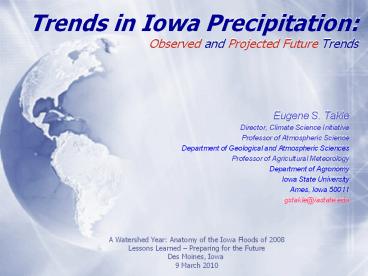Trends in Iowa Precipitation: Observed and Projected Future Trends - PowerPoint PPT Presentation
1 / 27
Title:
Trends in Iowa Precipitation: Observed and Projected Future Trends
Description:
Trends in Iowa Precipitation: Observed and Projected Future Trends Eugene S. Takle Director, Climate Science Initiative Professor of Atmospheric Science – PowerPoint PPT presentation
Number of Views:184
Avg rating:3.0/5.0
Title: Trends in Iowa Precipitation: Observed and Projected Future Trends
1
Trends in Iowa PrecipitationObserved and
Projected Future Trends
- Eugene S. Takle
- Director, Climate Science Initiative
- Professor of Atmospheric Science
- Department of Geological and Atmospheric Sciences
- Professor of Agricultural Meteorology
- Department of Agronomy
- Iowa State University
- Ames, Iowa 50011
- gstakle_at_iastate.edu
A Watershed Year Anatomy of the Iowa Floods of
2008 Lessons Learned Preparing for the
Future Des Moines, Iowa 9 March 2010
2
Observed Trends in Iowa Precipitation
3
State-Wide Average Data
4
State-Wide Average Data
37.5
31.5
19 increase
5
State-Wide Average Data
Totals above 40
8 years
2 years
6
State-Wide Average Data
7
(No Transcript)
8
Cedar Rapids Data
28.0
37.0
32 increase
9
Cedar Rapids Data
51 increase
11.8
7.8
10
Cedar Rapids Data
34 increase
20.2
26.8
11
One of the clearest trends in the United States
observational record is an increasing frequency
and intensity of heavy precipitation events Over
the last century there was a 50 increase in the
frequency of days with precipitation over 101.6
mm (four inches) in the upper midwestern U.S.
this trend is statistically significant
Karl, T. R., J. M. Melillo, and T. C. Peterson,
(eds.), 2009 Global Climate Change Impacts in
the United States. Cambridge University Press,
2009, 196pp.
12
Cedar Rapids Data
57 increase
6.6 days
4.2 days
13
Cedar Rapids Data
Years having more than 8 days
11
2
57 increase
6.6 days
4.2 days
14
(No Transcript)
15
Great Flood of 1993 in the US Midwest A New
Great Lake
Historical Data indicate this should happen about
once every 500 years
Lakshmi, V., and K. Schaaf, 2001 Analysis of
the 1993 Midwestern flood using satellite and
ground data. IEEE Trans. Geosci Remote Sens.,
39, 1736-1743.
16
Projected Future Trends in Iowa Precipitation
17
The future isnt what it used to be Yogi Berra
18
Global Carbon Emissions (Gt)
Actual emissions are exceeding worst case
scenarios projected in 1990
19
Source Jerry Meehl, National Center for
Atmospheric Research
20
Karl, T. R., J. M. Melillo, and T. C. Peterson,
(eds.), 2009 Global Climate Change Impacts in
the United States. Cambridge University Press,
2009, 196pp.
21
Karl, T. R., J. M. Melillo, and T. C. Peterson,
(eds.), 2009 Global Climate Change Impacts in
the United States. Cambridge University Press,
2009, 196pp.
22
Low confidence
Karl, T. R., J. M. Melillo, and T. C. Peterson,
(eds.), 2009 Global Climate Change Impacts in
the United States. Cambridge University Press,
2009, 196pp.
23
Trend of increase in occurrence of heavy
precipitation over the 20th C is consistent with
increasing GHG concentrations. Frequency of
intense precipitation events is likely to
increase in the future.
Karl, T. R., J. M. Melillo, and T. C. Peterson,
(eds.), 2009 Global Climate Change Impacts in
the United States. Cambridge University Press,
2009, 196pp.
24
Relationship of Streamflow to Precipitation in
Current and Future Climates
25
SWAT (RegCM2) 21 increase in precip -gt 50
increase in streamflow
Relationship of Streamflow to Precipitation in
Current and Future Climates
DrainMod (RegCM2) 24 increase in precip -gt
35 increase in tile drainage
DrainMod (HIRHAM) 32 increase in precip -gt
80 increase in tile drainage
26
Will These Iowa Precipitation Trends Continue?
Caution These are my speculations!!
- In the short-term (next 5-10 years) precipitation
characteristics will be dominated by natural
variability from base conditions of the past 30
years (not long-term averages) - If we continue to have high spring and summer
rainfall and soil moisture, we likely will
continue to have higher chances of flooding - In the longer term (gt50 years), hot summers,
milder winters, and higher variability of
precipitation will become more dominant - Failure to limit global carbon emissions will
accelerate trends toward more extremes of
precipitation compared to the 20th Century
27
For More Information
- North American Regional Climate Change Assessment
Program http//www.narccap.ucar.edu/ - For current activities on the ISU campus,
regionally and nationally relating to climate
change see the Climate Science Initiative
website http//climate.agron.iastate.edu/ - Contact me directly gstakle_at_iastate.edu































